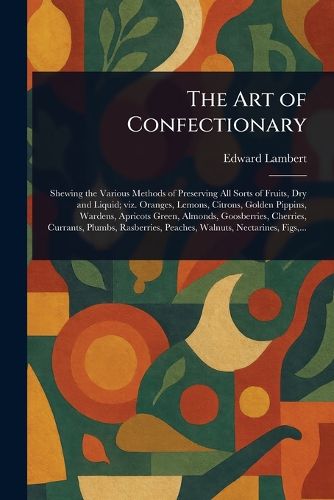Readings Newsletter
Become a Readings Member to make your shopping experience even easier.
Sign in or sign up for free!
You’re not far away from qualifying for FREE standard shipping within Australia
You’ve qualified for FREE standard shipping within Australia
The cart is loading…






This title is printed to order. This book may have been self-published. If so, we cannot guarantee the quality of the content. In the main most books will have gone through the editing process however some may not. We therefore suggest that you be aware of this before ordering this book. If in doubt check either the author or publisher’s details as we are unable to accept any returns unless they are faulty. Please contact us if you have any questions.
Delve into the sweet history of baking with Edward Lambert's "The Art of Confectionary," a fascinating glimpse into the world of early dessert making. This meticulously prepared print edition offers a treasure trove of historical recipes and techniques, transporting you to a time when confectionery was a true art form.
Explore detailed instructions for creating a wide array of desserts, from elaborate cakes to delicate candies. Discover the ingredients and methods employed by cooks in centuries past. This book provides a unique perspective on the evolution of culinary practices and the enduring appeal of sweet treats.
Whether you're a seasoned baker, a history enthusiast, or simply curious about the origins of your favorite desserts, "The Art of Confectionary" is a delightful journey through time. Experience the time-honored traditions of confectionery and unlock the secrets to creating classic desserts that continue to inspire.
This work has been selected by scholars as being culturally important, and is part of the knowledge base of civilization as we know it.
This work is in the public domain in the United States of America, and possibly other nations. Within the United States, you may freely copy and distribute this work, as no entity (individual or corporate) has a copyright on the body of the work.
Scholars believe, and we concur, that this work is important enough to be preserved, reproduced, and made generally available to the public. We appreciate your support of the preservation process, and thank you for being an important part of keeping this knowledge alive and relevant.
$9.00 standard shipping within Australia
FREE standard shipping within Australia for orders over $100.00
Express & International shipping calculated at checkout
This title is printed to order. This book may have been self-published. If so, we cannot guarantee the quality of the content. In the main most books will have gone through the editing process however some may not. We therefore suggest that you be aware of this before ordering this book. If in doubt check either the author or publisher’s details as we are unable to accept any returns unless they are faulty. Please contact us if you have any questions.
Delve into the sweet history of baking with Edward Lambert's "The Art of Confectionary," a fascinating glimpse into the world of early dessert making. This meticulously prepared print edition offers a treasure trove of historical recipes and techniques, transporting you to a time when confectionery was a true art form.
Explore detailed instructions for creating a wide array of desserts, from elaborate cakes to delicate candies. Discover the ingredients and methods employed by cooks in centuries past. This book provides a unique perspective on the evolution of culinary practices and the enduring appeal of sweet treats.
Whether you're a seasoned baker, a history enthusiast, or simply curious about the origins of your favorite desserts, "The Art of Confectionary" is a delightful journey through time. Experience the time-honored traditions of confectionery and unlock the secrets to creating classic desserts that continue to inspire.
This work has been selected by scholars as being culturally important, and is part of the knowledge base of civilization as we know it.
This work is in the public domain in the United States of America, and possibly other nations. Within the United States, you may freely copy and distribute this work, as no entity (individual or corporate) has a copyright on the body of the work.
Scholars believe, and we concur, that this work is important enough to be preserved, reproduced, and made generally available to the public. We appreciate your support of the preservation process, and thank you for being an important part of keeping this knowledge alive and relevant.